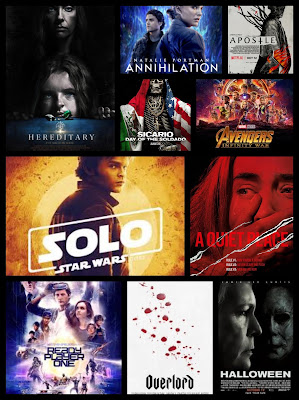Battle of the Oscars: The Shape of Water v Three Billboards Outside Ebbing, Missouri
 Get Out is probably the biggest surprise nomination out of the bunch as I thought it was a perfectly good film, great even, but in terms of really knocking it out of the park with directorial flare it isn't super. However, the subtext and plotting really elevates the film and places it at the forefront of films today for tackling the "big themes" that modern culture is dealing with. Coupled with the Oscar controversy a few years ago of "#Oscarssowhite" it isn't surprising that the film has had such an impact on the voting panel.
Get Out is probably the biggest surprise nomination out of the bunch as I thought it was a perfectly good film, great even, but in terms of really knocking it out of the park with directorial flare it isn't super. However, the subtext and plotting really elevates the film and places it at the forefront of films today for tackling the "big themes" that modern culture is dealing with. Coupled with the Oscar controversy a few years ago of "#Oscarssowhite" it isn't surprising that the film has had such an impact on the voting panel.Normally, I'd be backing a horror film all the way to go for best picture, as it is a category the Oscars have been immensely sniffy about in the past. Having snubbed big critical horror hitters like The Witch, and The Babadook, you have to go back a long way to find any best picture horror winners, specifically to The Silence of the Lambs.
However, in the past few weeks I've seen two films which are up for best picture which I think are ahead of the game compared to Get Out: The Shape of Water and Three Billboards.
 The Shape of the Water is the 10th full length feature film from one of my favourite directors Guillermo Del Toro. Del Toro was first properly introduced to me through his 2006 best foreign language nominated film Pan's Labyrinth, and I've been hooked ever since. Not afraid to go big on genre, particularly horror, the guy's got a fantastic vision and imagination, being inspired by H.P Lovecraft and the monster movies of Universal. Up until The Shape of Water, Del Toro's Spanish language films have been his true classics, with Pan's Labyrinth and The Devil's Backbone being classic ghost stories.
The Shape of the Water is the 10th full length feature film from one of my favourite directors Guillermo Del Toro. Del Toro was first properly introduced to me through his 2006 best foreign language nominated film Pan's Labyrinth, and I've been hooked ever since. Not afraid to go big on genre, particularly horror, the guy's got a fantastic vision and imagination, being inspired by H.P Lovecraft and the monster movies of Universal. Up until The Shape of Water, Del Toro's Spanish language films have been his true classics, with Pan's Labyrinth and The Devil's Backbone being classic ghost stories.Now, however, I think Del Toro has a true knockout of an English language film and made a real contender for best picture with The Shape of Water. The film follows Elisa, a mute woman working in a secret government lab in the 1960s as a cleaner. Working under the leering and patronising gaze of her male superiors, she is allowed access to the facility's top secret projects as, hey what's a woman going to understand, right? One day, she sees the latest project at the facility, a humanoid fish-man, kept locked up and tortured in the facility. The fish-man design is played by Del Toro regular and man-in-makeup pro, Doug Jones (see The Gentlemen in Buffy, The Pale Man in Pan's Labyrinth, and probable relative of the creature in Shape of Water, Abe Sapien in Hellboy) and is clearly inspired by the classic creature feature The Creature from the Black Lagoon.
The fish-man and Elisa start to form a bond through their own method of communication, as each is unable to speak. These interactions do not go unnoticed by the higher ups, in particularly the mercilessly sleazy Michael Shannon, and soon Elisa is left with a do or die choice to continue her relationship with the fish-man.
Del Toro surpasses has past displays of aesthetics and set design, creating a murky, Bioshock-esque world, full of sea greens and dripping pipes. The creature itself is a wonderful creation, flitting between sympathetic eyes, and potentially blood-curdling violence when needed. Del Toro's eye for cinematography is also in full swing here, with the camera often gliding across the sets, almost like a swimming beast itself. This becomes particularly apparent when the film highlights the importance of music between the Elisa and the creature.
So far, so standard for a monster movie. However, as with past Del Toro flicks, it is clear that Del Toro's sympathy lies with the monster and the outsider, and the creature and Elisa, as well as a cast of fantastic supporting characters, all fit into these moulds. Elisa is a mute woman working in the 1960s, equally ignored by her male co-workers due to her sex, as well as equally objectified due to her sex. Elisa's closest co-worker is a black woman, and her neighbour is a closeted gay man. Together, with the creature, they form the outsiders, against the true monster that is Michael Shannon's suited beast.
Sally Hawkins is fantastic as Elisa, playing a surely challenging role, having to emote purely through gestures. She sells the central relationship between herself and the creature. Whilst it may seem like Oscar-bait to play a character who has some form of "disability" the key here is that you never associate the word "disabled" with Elisa - she's a capable, confident, intelligent character, who may be looked down upon by others for what they perceive as a weakness, but that weakness is never acknowledged by her.
It is worth mentioning that the film is by no means "mainstream" or family friendly. There is sex, blood, gore, and profanity about and the story goes to some really out there places that in lesser hands would simply not land. But it is a testament to the team involved in the film that each story beat hits and builds towards a fantastic conclusion. For me, normally enjoying things as bleak as possible, it was a rare treat to see a film that was not insulting my intelligence whilst also leaving me with a smile a mile wide throughout. The film is a real treat.
On the other hand, Three Billboards will make you smile, and laugh, but it is most certainly not a feel good film. The director, Martin McDonagh, had previously directed the brilliant dark comedy In Bruges, and the less so brilliant Seven Psychopaths. For Three Billboards, the director brings his pristine mix of drama and dark comedy to the fore, switching between the absurd and bleak on a dime.
The plot is, at the risk of sounding dense, about three billboards outside Ebbing, Missouri, hired by the grieving firebrand matriarch Mildred, played fantastically by Frances McDormand. Seven months prior to the start of the film, her daughter was raped and murdered, and the guilty party is still unknown. Driven to dark frustration by the supposed inaction of the local police, led by Chief Willoughby, Woody Harrelson playing against type, she hires the three billboards and places three inflammatory messages on each one, relating to her daughter's rape and murder. This catches the attention of just about everyone in town and the consequences start to spiral out of control.
From the off, you know that whilst the film may have laughs, the central theme of the film is pitch black. Mildred may have a righteous fury, and it may be tempting to get behind her, but her aim is often misguided and results in terrible consequences. McDormand plays the role as if it is on a tightrope, one step too far to the left or right and we lose total sympathy. The role is somewhat similar to Bryan Cranston's Walter White, in that film maintains the wonderful hypothesis that just because a character is a protagonist does not mean they are a hero, and more specifically they we do not need to agree with the totality of a character's actions to find something to admire.
This adherence to refusing to painting its characters in black and white is the film's greatest strength and is shown in the most surprising ways by certain secondary characters. I won't divulge their identity lest spoil the surprise, but the character in question has been the subject of some, in my opinion, dunderheaded critiques that fail to acknowledge that humans are rarely heroes or supervillains, and that we are instead people who paint ourselves as heroes in our head yet often do bad things for good reasons, and vice versa. That critique suffers from a lack of nuance in that it ignores the fact that the audience is smart and can read the shades of grey of characters doing deplorable things, whilst later doing something positive that we should not discount. In our "post-truth" times of apparently clearly defined battlegrounds of left v right wing politics, this muddying of the waters should be applauded.
Aside for the juicy subtext in the film, Three Billboards does manage gallows laughs on many an occasion. The strength of these laughs are often made apparent by the skill in which McDonagh can have you laughing aloud at some fantastically placed vulgarity, before gasping in horror a beat later. The highlight for me is a flashback sequence set about a kitchen conversation that peaks with a wonderful zinger of a comeback before smashing headfirst into true bleak pathos.
The film is carried expertly by the three leads of McDormand, Harrelson, and Sam Rockwell, as a slightly dopey hick cop in Harrelson's department. Harrelson probably has the most surprising role in the film, playing against the character type and creating the catalyst for the muddying morals of the other characters as the film progresses. McDormand is consistently mesmerising throughout the film, with a foul mouth and blazing heart, if she's on screen, you're looking and listening. Rockwell brings many of the films bigger laughs but again also subverts his character's role at certain key points to keep you guessing. It all culminates in an ending that refuses to tie things into a nice neat bow, nor does it espouse a hunky dory message of simply forgive and forget but aims for something much more murky.
The best picture category this year is a real pleasant surprise for me, seeing some true oddball contenders and genre flicks eking out an existence in a normally bland award show. If I had to choose between The Shape of Water and Three Billboards, I'd have to pick Shape of Water for best picture for bringing something truly new and grin inducing to the table, whereas I think I'd tip McDormand for best actress for a blisteringly memorable role. Either way, I'd say Oscars have finally gotten it right. At this rate, if someone were to suggest a horror movie would win best picture next year my response would not be to get out.









Comments
Post a Comment